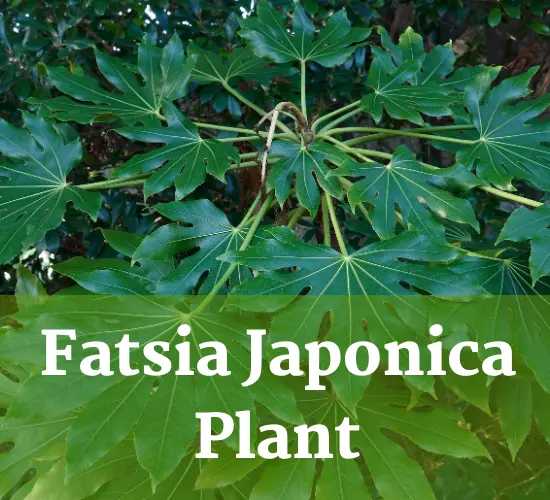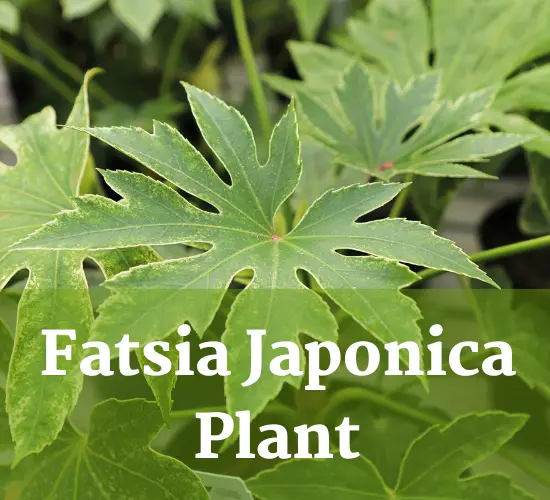Table of Contents
Care of Fatsia Japonica: Tips for Healthy Growth and Maintenance
Fatsia Japonica, also known as Japanese aralia, is a popular choice among garden enthusiasts due to its striking foliage and ability to thrive in various conditions.
In this article, we will provide you with essential tips for ensuring the healthy growth and maintenance of this beautiful plant. By following these guidelines, you will be able to cultivate and maintain a flourishing Fatsia Japonica in your garden.
| Property/Fact | Description |
|---|---|
| Scientific Name | Fatsia Japonica |
| Common Names | Japanese Aralia, Japanese Fatsia, Aralia Sieboldii |
| Appearance | Large, glossy, palmate leaves with 7-9 deep lobes per leaf; can measure up to 14 inches wide |
| Adaptability | Can thrive in a variety of conditions, from full sun to partial shade |
| Growing Conditions | Requires well-draining soil that is kept consistently moist; thrives in bright, indirect light and prefers temperatures between 60 and 75 degrees Fahrenheit |
| Propagation | Can be propagated through stem cuttings or by dividing the plant |
| Ornamental Features | Grown primarily as an evergreen foliage plant; has a tropical appearance due to the bold, dark green, shiny foliage |
| Cultivars | ‘Variegata’ has irregularly white-edged leaves; ‘Spider’s Web’ has heavy white speckling over the entire leaf and pale leaf veins |
| Maintenance | Low maintenance; fertilize lightly in the spring with a slow-release tree and shrub fertilizer |
| Pests and Diseases | Can be affected by spider mites, mealybugs, and scale insects; regular inspection and treatment can prevent these issues from becoming severe |
| Uses | Can be used as an ornamental plant in gardens and indoor spaces; can also be used as long-lasting cut foliage for flower arrangements |
Key Takeaways

- Fatsia plants thrive in bright indirect light and warm environments but can tolerate low light conditions.
- Watering should be done when the top inch of soil feels partially dry to prevent overwatering and root rot.
- Fatsia plants should be fertilized with a general houseplant fertilizer 1-2 times a month during spring and summer.
- Regular pruning and repotting are essential for maintaining the size and health of Fatsia plants.
Planting Fatsia Japonica
To successfully plant Fatsia Japonica, it is essential to choose a suitable location and prepare the soil accordingly. When planting in a pot, ensure that it has a drainage hole to prevent waterlogging, which can lead to root rot. Fatsia Japonica prefers a well-draining soil rich in organic matter. By selecting the right location and preparing the soil properly, you can ensure successful planting and optimal growth of Fatsia Japonica.
To give Fatsia Japonica the best chance of thriving, it is recommended to prune any damaged or dead foliage before planting. This promotes healthy growth and prevents the spread of diseases. Consider adding compost or peat moss to the soil to improve its fertility and provide essential nutrients for the plant.
Whether you choose to plant Fatsia Japonica in a pot or directly in the ground depends on personal preference and available space. If planting in a pot, make sure the stem of the plant is planted at the same depth as it was in the original container. This helps to maintain stability and encourages proper root development.
Location plays a crucial role in the growth of Fatsia Japonica. It is important to choose a spot that receives bright, indirect sunlight. While this plant can tolerate some shade, it thrives in well-lit areas.
Soil preparation is another key factor. It is essential to ensure that the soil is well-draining and rich in organic matter. A mix of potting soil, peat moss, and perlite works well for Fatsia Japonica. Heavy clay soils should be avoided as they tend to retain too much moisture.
Fertilizer is necessary to promote healthy growth. Using a balanced liquid fertilizer during the growing season is recommended. Dilute the fertilizer according to the package instructions and apply it every two weeks.
Humidity levels are important for Fatsia Japonica. This plant prefers high humidity. Regularly mist the leaves or place a tray filled with water near the plant to increase humidity.
Watering and Fertilizing

Regularly watering and fertilizing Fatsia Japonica is crucial for maintaining its healthy growth and overall well-being.
Proper watering is essential to keep the soil consistently moist, but not waterlogged. It is recommended to water the plant deeply once a week, allowing the top inch of soil to dry out between waterings. During hot and dry periods, more frequent watering may be necessary.
Fertilizing is equally important to provide the necessary nutrients for the plant’s growth. Apply a balanced fertilizer, such as a 10-10-10 or 20-20-20 formula, in early spring and again in mid-summer. Follow the package instructions for the correct dosage based on the size of your Fatsia Japonica. Avoid over-fertilizing, as it can lead to excessive leaf growth and weaken the plant.
With proper watering and fertilizing, your Fatsia Japonica will thrive and maintain its healthy growth for years to come.
Pruning and Maintenance
Pruning and Maintenance of Fatsia Japonica plays a vital role in ensuring the optimal health and growth of the plant. Understanding the proper techniques for pruning and maintaining this plant is essential. Pruning helps in shaping the plant and promoting healthy growth, while regular maintenance ensures its longevity.
Let’s explore some helpful tips for pruning and maintenance of Fatsia Japonica:
1. Pruning:
- Remove any dead or damaged branches to maintain the plant’s overall health.
- Trim back overgrown branches to maintain the desired size and shape of the plant.
- Prune in early spring to encourage new growth and rejuvenation.
2. Maintenance:
- Regularly check for pests and treat them accordingly to prevent infestation and damage.
- Keep the soil evenly moist to provide adequate hydration, but avoid overwatering to prevent root rot.
- Ensure adequate lighting for indoor Fatsia Japonica, as it is an evergreen plant and requires sufficient light for photosynthesis.
- Fertilize with a balanced, water-soluble fertilizer during the growing season to promote healthy foliage and overall plant growth.
Common Problems and Solutions
In the context of caring for Fatsia Japonica, one common problem that may arise is the occurrence of pests and diseases. This plant can be affected by common pests such as aphids, spider mites, and scale insects, which can cause damage to the leaves and stems, leading to a decline in overall health. To prevent and treat pest infestations, regular inspections and the use of insecticidal soaps or horticultural oils can be effective.
Fatsia Japonica is susceptible to fungal infections such as powdery mildew and root rot. Proper watering and good air circulation are important preventative measures against these diseases. If a disease does occur, removing affected plant parts and applying fungicides can help control the spread.
Another issue that Fatsia Japonica may experience is variegation problems, characterized by the appearance of white or yellow markings on the leaves. This is usually caused by inadequate light or poor nutrition. To address this, placing the plant in a well-lit area or providing supplemental artificial light can help improve coloration. Additionally, ensuring the plant receives sufficient nutrients through regular fertilization can promote healthy growth and vibrant foliage.
When growing Fatsia Japonica indoors, it is important to replicate its natural growing conditions as closely as possible. This includes providing it with moist soil and maintaining humidity levels. By being proactive in identifying and addressing common problems, Fatsia Japonica can thrive and remain healthy throughout the growing season.
Propagation Methods
Propagation Methods
To propagate Fatsia Japonica, gardeners can utilize the plant’s natural ability to produce new growth by using stem cuttings.
Here are four propagation methods to consider:
- Stem cuttings: Take a 6-inch stem cutting from the plant, making sure to include a node. Remove the lower leaves and dip the cut end in the rooting hormone before planting it in a well-draining soil mix.
- Division: Carefully dig up the plant and divide the root ball into smaller sections. Each section should have some stems and roots. Replant the divisions in separate pots or in the garden.
- Air layering: Select a healthy stem and make a small cut in the bark. Dust the wound with rooting hormone and wrap it with damp sphagnum moss. Secure the moss with plastic wrap and wait for roots to form before cutting and planting the new plant.
- Seed propagation: Collect ripe seeds from the white flowers of the Japanese Aralia. Sow the seeds in a well-draining soil mix and keep them in a warm, humid environment until they germinate.
Conclusion
In conclusion, by following proper care techniques such as planting in well-drained soil, regular watering and fertilizing, and occasional pruning, Fatsia japonica can thrive and remain healthy.
Additionally, addressing common problems such as pests and diseases promptly can ensure the plant’s longevity.
Propagation methods can also be employed to expand your collection or share with others.
By implementing these tips, you can enjoy the beauty and benefits of Fatsia japonica in your garden.
Frequently Asked Questions
Can Fatsia plants be grown outdoors in colder climates?
Growing Fatsia plants in colder climates can be challenging. However, with proper care and overwintering techniques such as mulching and providing protection from harsh weather conditions, it is possible to successfully grow Fatsia plants outdoors in colder regions.
Are there any pests or diseases that commonly affect Fatsia plants?
Common pests and diseases of fatsia plants include aphids, spider mites, and scale insects, as well as fungal diseases such as powdery mildew and root rot. Prevention involves regular inspection, maintaining proper humidity levels, and using appropriate pesticides or fungicides for treatment.
Can Fatsia plants be propagated from cuttings?
Propagating fatsia plants is like giving wings to their beauty. By taking cuttings from a healthy plant, you can create new offspring. This not only expands your collection but also ensures the continuation of their stunning foliage. The benefits of propagating fatsia plants include the ability to share their beauty with others and the freedom to create a thriving garden.
Is it necessary to fertilize Fatsia plants during the winter months?
Fertilizing schedule for Fatsia plants during winter care is not necessary as they go through a period of dormancy. However, if desired, a reduced feeding frequency of once every 2-3 months with a diluted houseplant fertilizer can be implemented.
How often should Fatsia plants be watered during the dormant period?
During the dormant period, Fatsia plants should be watered sparingly to prevent overwatering. It is recommended to wait until the soil is completely dry before watering, as excessive moisture can lead to root rot.
4 thoughts on “The Ultimate Guide for Grow and Care of Fatsia Japonica (Japanese Aralia): The Perfect Plant Care Manual”